Analysis of Nestle's Business Environment: Key Factors and Policies
VerifiedAdded on 2020/02/03
|18
|4754
|94
Report
AI Summary
This report provides a detailed analysis of Nestle's business environment, examining key factors such as market structure, monetary and fiscal policies, and the impact of cultural and international trade. It explores the organizational structure, stakeholder objectives, and ethical responsibilities of Nestle, including environmental and customer-related issues. The report assesses the influence of economic systems and analyzes how Nestle meets the objectives of various stakeholders, including employees, customers, and environmental groups. Furthermore, it discusses the responsibilities of Nestle concerning ethical issues, customer legislation, fair trade, and compliance strategies. The report also delves into the impact of fiscal and monetary policies on Nestle's business activities, providing a comprehensive overview of the company's operations within its national and global environment.
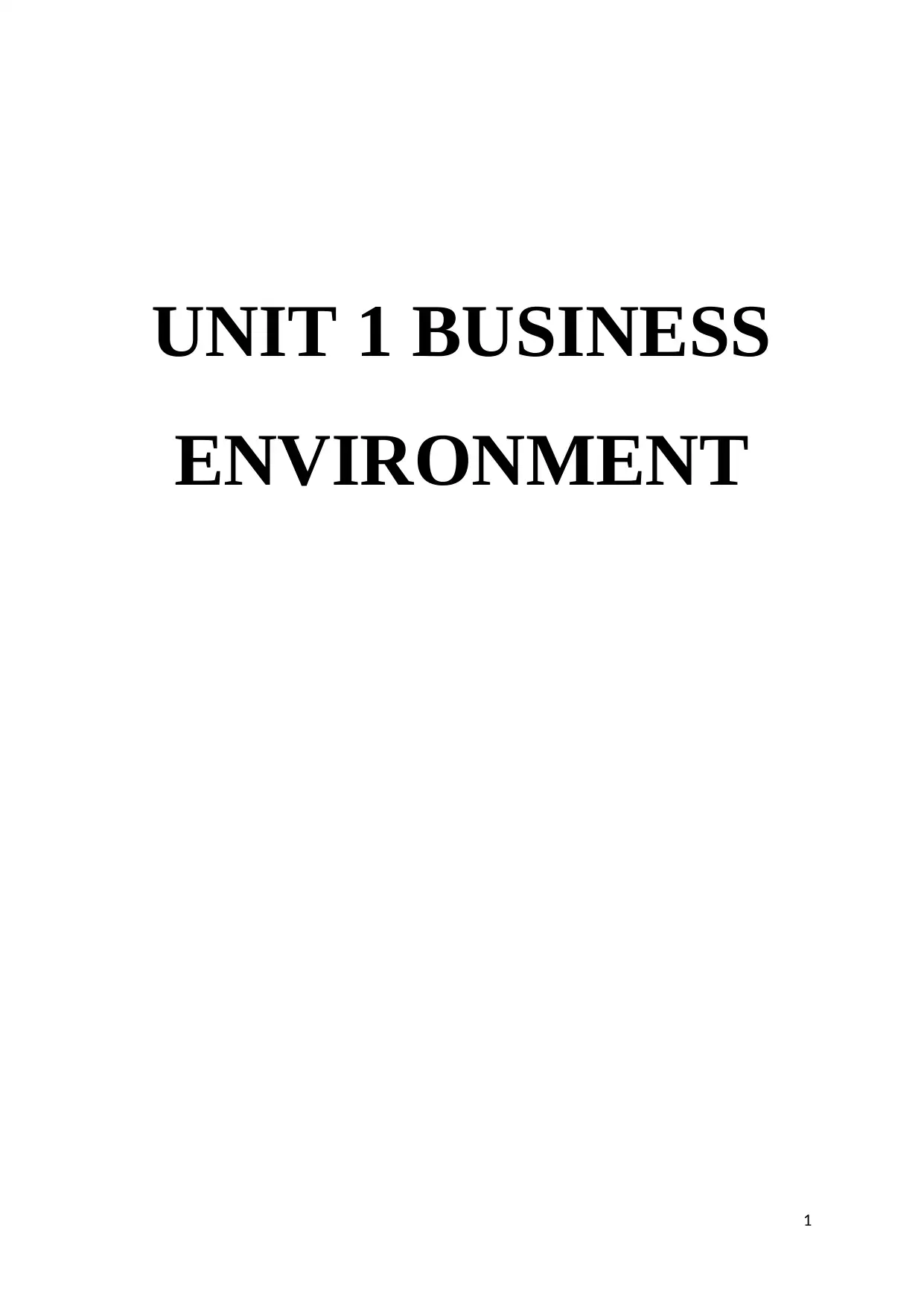
UNIT 1 BUSINESS
ENVIRONMENT
1
ENVIRONMENT
1
Paraphrase This Document
Need a fresh take? Get an instant paraphrase of this document with our AI Paraphraser
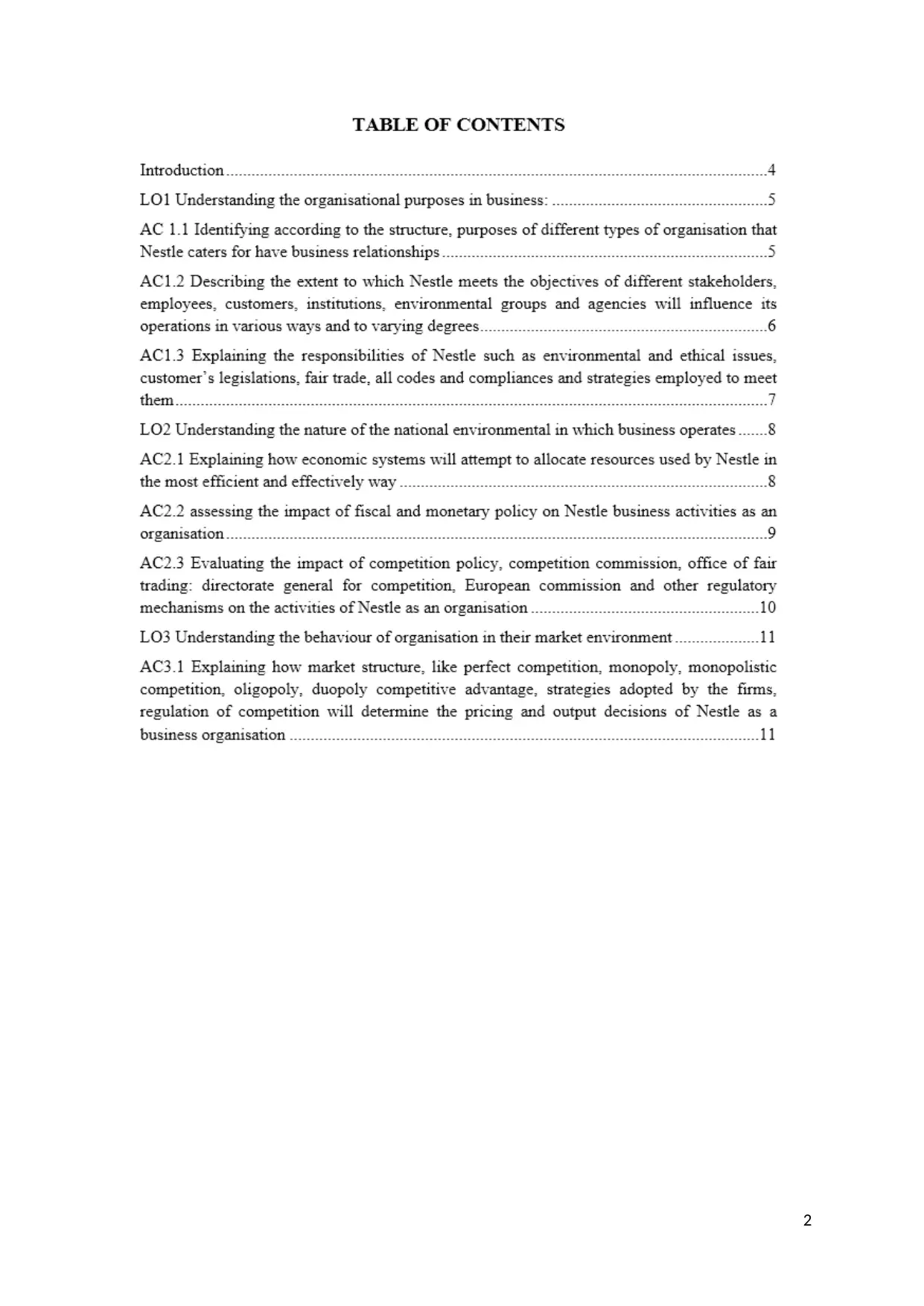
2
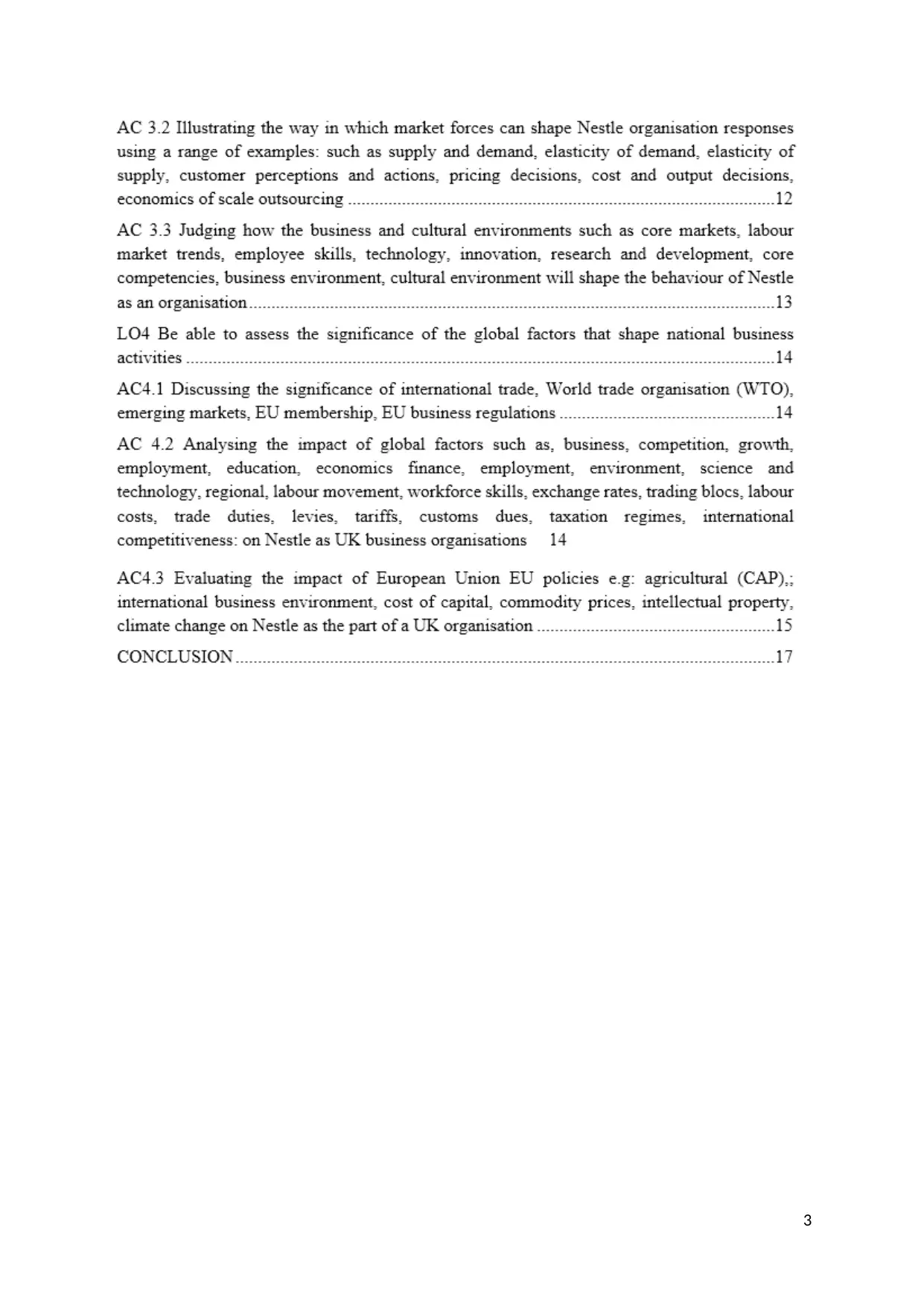
3
⊘ This is a preview!⊘
Do you want full access?
Subscribe today to unlock all pages.

Trusted by 1+ million students worldwide
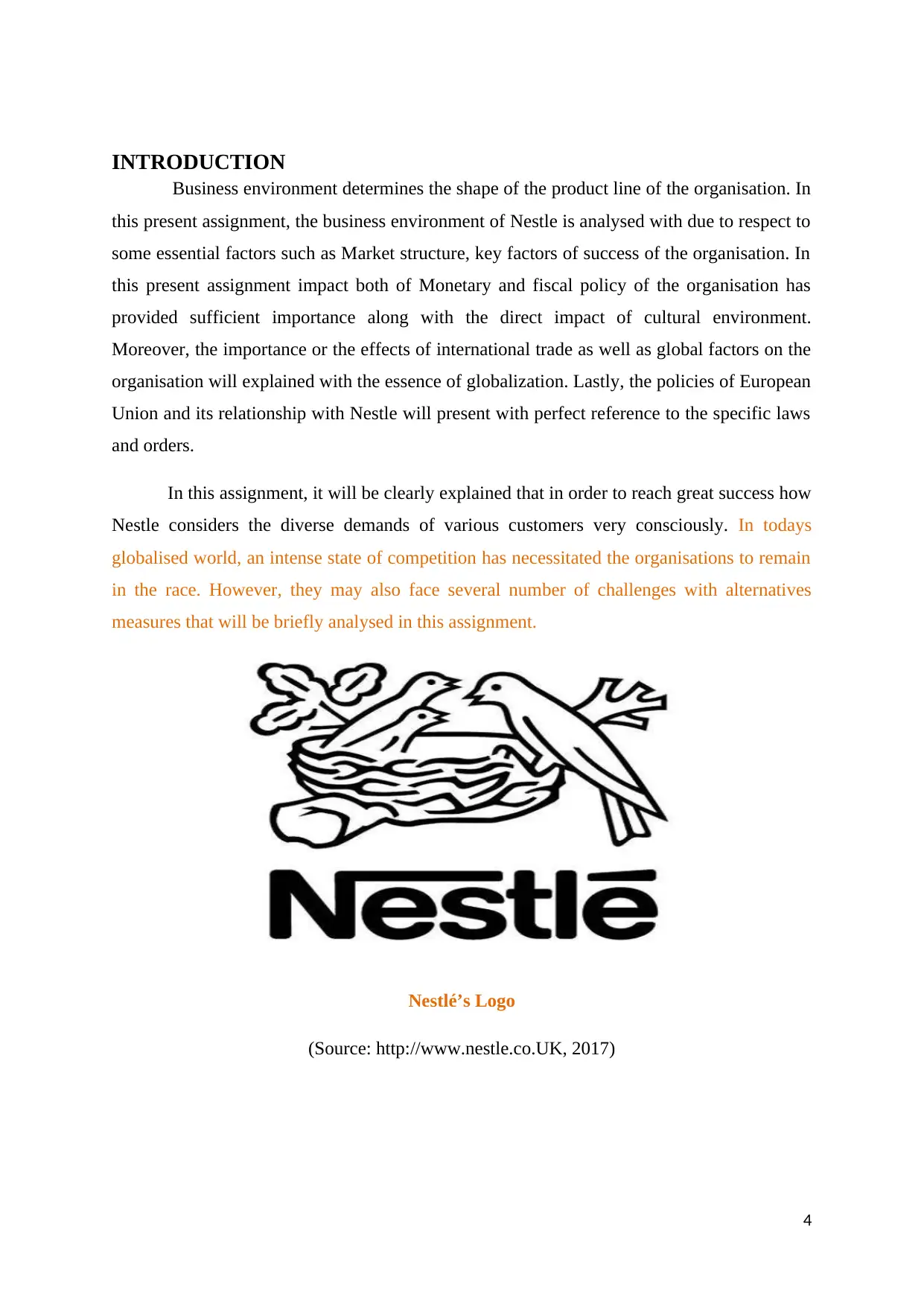
INTRODUCTION
Business environment determines the shape of the product line of the organisation. In
this present assignment, the business environment of Nestle is analysed with due to respect to
some essential factors such as Market structure, key factors of success of the organisation. In
this present assignment impact both of Monetary and fiscal policy of the organisation has
provided sufficient importance along with the direct impact of cultural environment.
Moreover, the importance or the effects of international trade as well as global factors on the
organisation will explained with the essence of globalization. Lastly, the policies of European
Union and its relationship with Nestle will present with perfect reference to the specific laws
and orders.
In this assignment, it will be clearly explained that in order to reach great success how
Nestle considers the diverse demands of various customers very consciously. In todays
globalised world, an intense state of competition has necessitated the organisations to remain
in the race. However, they may also face several number of challenges with alternatives
measures that will be briefly analysed in this assignment.
Nestlé’s Logo
(Source: http://www.nestle.co.UK, 2017)
4
Business environment determines the shape of the product line of the organisation. In
this present assignment, the business environment of Nestle is analysed with due to respect to
some essential factors such as Market structure, key factors of success of the organisation. In
this present assignment impact both of Monetary and fiscal policy of the organisation has
provided sufficient importance along with the direct impact of cultural environment.
Moreover, the importance or the effects of international trade as well as global factors on the
organisation will explained with the essence of globalization. Lastly, the policies of European
Union and its relationship with Nestle will present with perfect reference to the specific laws
and orders.
In this assignment, it will be clearly explained that in order to reach great success how
Nestle considers the diverse demands of various customers very consciously. In todays
globalised world, an intense state of competition has necessitated the organisations to remain
in the race. However, they may also face several number of challenges with alternatives
measures that will be briefly analysed in this assignment.
Nestlé’s Logo
(Source: http://www.nestle.co.UK, 2017)
4
Paraphrase This Document
Need a fresh take? Get an instant paraphrase of this document with our AI Paraphraser
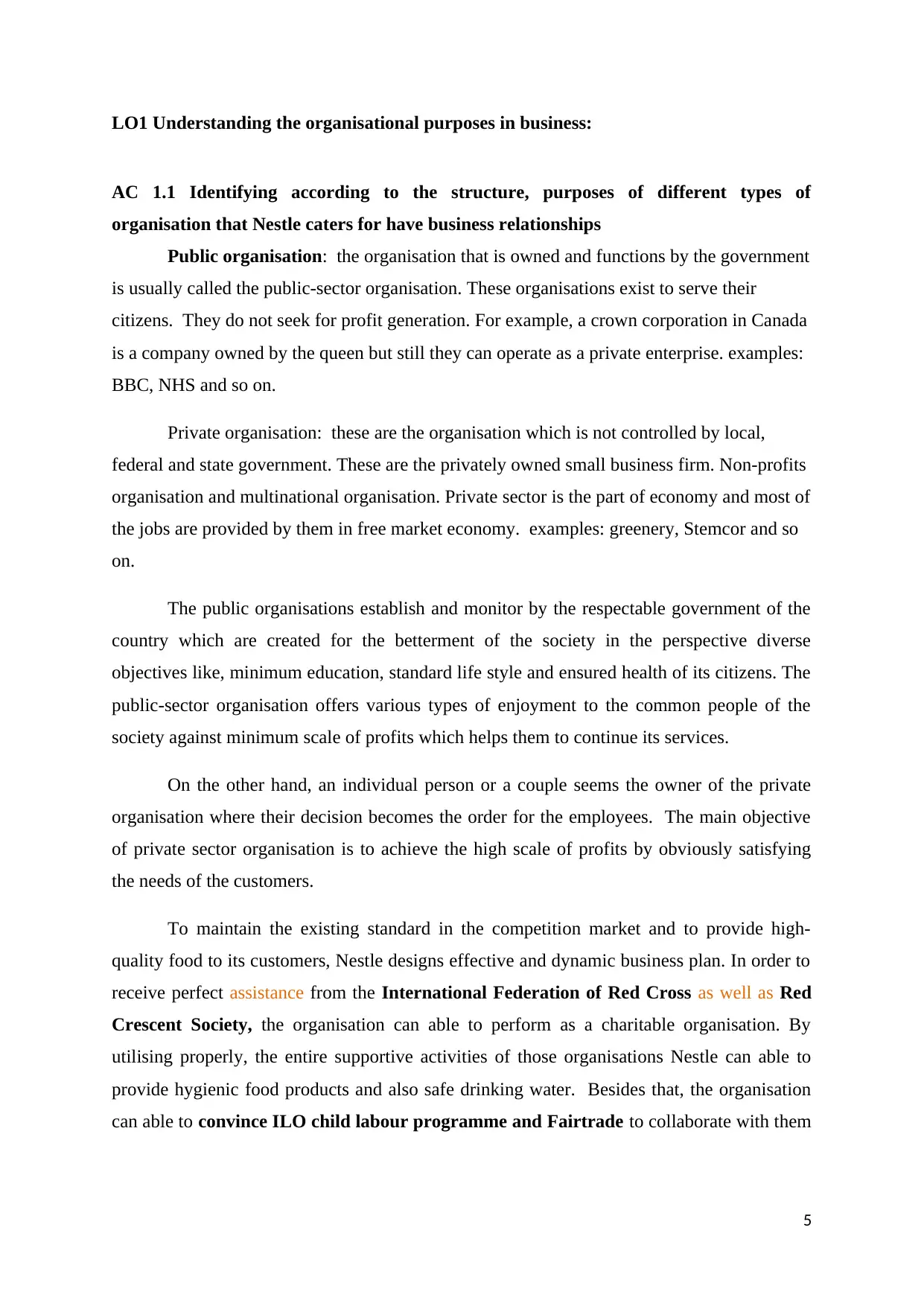
LO1 Understanding the organisational purposes in business:
AC 1.1 Identifying according to the structure, purposes of different types of
organisation that Nestle caters for have business relationships
Public organisation: the organisation that is owned and functions by the government
is usually called the public-sector organisation. These organisations exist to serve their
citizens. They do not seek for profit generation. For example, a crown corporation in Canada
is a company owned by the queen but still they can operate as a private enterprise. examples:
BBC, NHS and so on.
Private organisation: these are the organisation which is not controlled by local,
federal and state government. These are the privately owned small business firm. Non-profits
organisation and multinational organisation. Private sector is the part of economy and most of
the jobs are provided by them in free market economy. examples: greenery, Stemcor and so
on.
The public organisations establish and monitor by the respectable government of the
country which are created for the betterment of the society in the perspective diverse
objectives like, minimum education, standard life style and ensured health of its citizens. The
public-sector organisation offers various types of enjoyment to the common people of the
society against minimum scale of profits which helps them to continue its services.
On the other hand, an individual person or a couple seems the owner of the private
organisation where their decision becomes the order for the employees. The main objective
of private sector organisation is to achieve the high scale of profits by obviously satisfying
the needs of the customers.
To maintain the existing standard in the competition market and to provide high-
quality food to its customers, Nestle designs effective and dynamic business plan. In order to
receive perfect assistance from the International Federation of Red Cross as well as Red
Crescent Society, the organisation can able to perform as a charitable organisation. By
utilising properly, the entire supportive activities of those organisations Nestle can able to
provide hygienic food products and also safe drinking water. Besides that, the organisation
can able to convince ILO child labour programme and Fairtrade to collaborate with them
5
AC 1.1 Identifying according to the structure, purposes of different types of
organisation that Nestle caters for have business relationships
Public organisation: the organisation that is owned and functions by the government
is usually called the public-sector organisation. These organisations exist to serve their
citizens. They do not seek for profit generation. For example, a crown corporation in Canada
is a company owned by the queen but still they can operate as a private enterprise. examples:
BBC, NHS and so on.
Private organisation: these are the organisation which is not controlled by local,
federal and state government. These are the privately owned small business firm. Non-profits
organisation and multinational organisation. Private sector is the part of economy and most of
the jobs are provided by them in free market economy. examples: greenery, Stemcor and so
on.
The public organisations establish and monitor by the respectable government of the
country which are created for the betterment of the society in the perspective diverse
objectives like, minimum education, standard life style and ensured health of its citizens. The
public-sector organisation offers various types of enjoyment to the common people of the
society against minimum scale of profits which helps them to continue its services.
On the other hand, an individual person or a couple seems the owner of the private
organisation where their decision becomes the order for the employees. The main objective
of private sector organisation is to achieve the high scale of profits by obviously satisfying
the needs of the customers.
To maintain the existing standard in the competition market and to provide high-
quality food to its customers, Nestle designs effective and dynamic business plan. In order to
receive perfect assistance from the International Federation of Red Cross as well as Red
Crescent Society, the organisation can able to perform as a charitable organisation. By
utilising properly, the entire supportive activities of those organisations Nestle can able to
provide hygienic food products and also safe drinking water. Besides that, the organisation
can able to convince ILO child labour programme and Fairtrade to collaborate with them
5
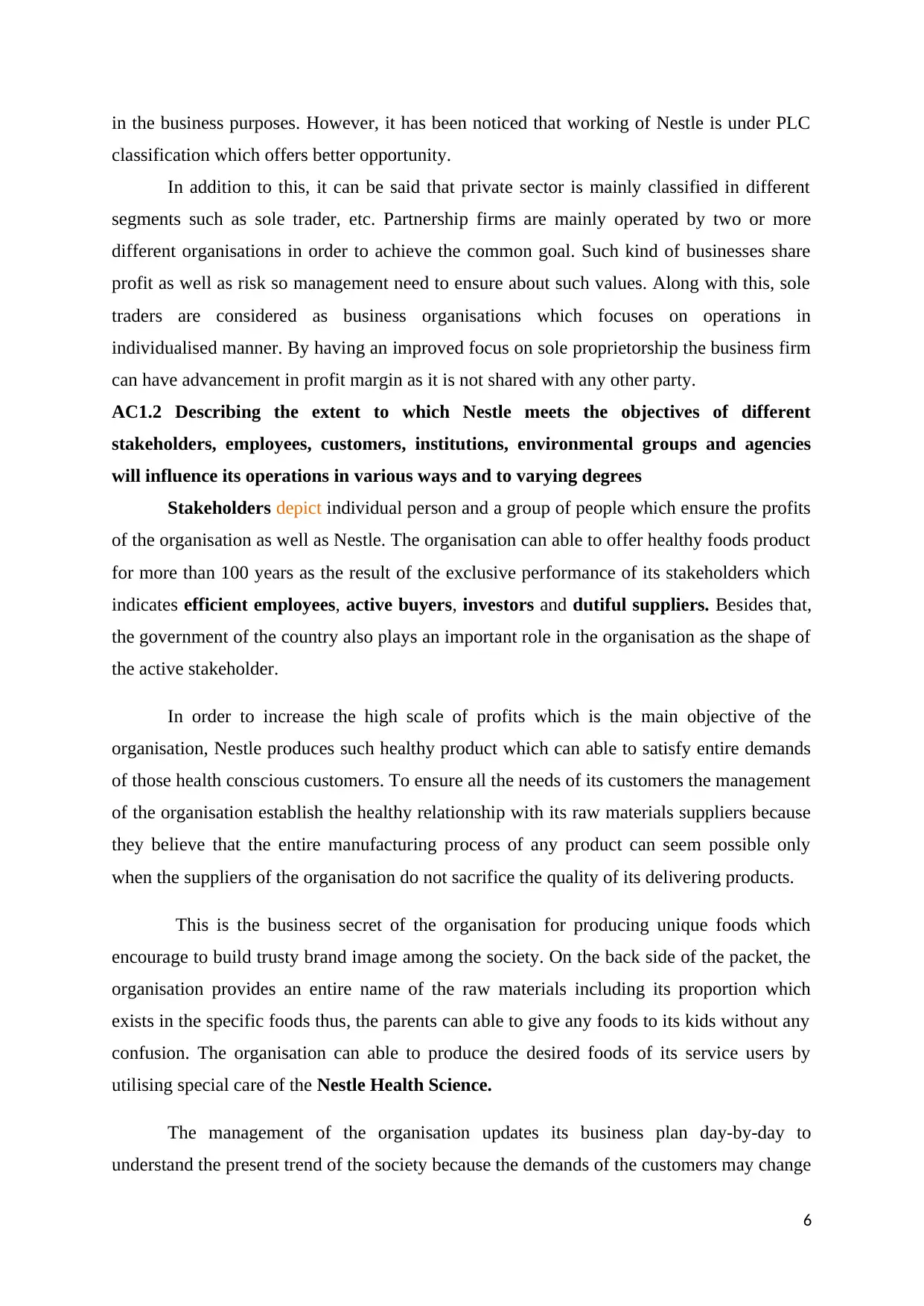
in the business purposes. However, it has been noticed that working of Nestle is under PLC
classification which offers better opportunity.
In addition to this, it can be said that private sector is mainly classified in different
segments such as sole trader, etc. Partnership firms are mainly operated by two or more
different organisations in order to achieve the common goal. Such kind of businesses share
profit as well as risk so management need to ensure about such values. Along with this, sole
traders are considered as business organisations which focuses on operations in
individualised manner. By having an improved focus on sole proprietorship the business firm
can have advancement in profit margin as it is not shared with any other party.
AC1.2 Describing the extent to which Nestle meets the objectives of different
stakeholders, employees, customers, institutions, environmental groups and agencies
will influence its operations in various ways and to varying degrees
Stakeholders depict individual person and a group of people which ensure the profits
of the organisation as well as Nestle. The organisation can able to offer healthy foods product
for more than 100 years as the result of the exclusive performance of its stakeholders which
indicates efficient employees, active buyers, investors and dutiful suppliers. Besides that,
the government of the country also plays an important role in the organisation as the shape of
the active stakeholder.
In order to increase the high scale of profits which is the main objective of the
organisation, Nestle produces such healthy product which can able to satisfy entire demands
of those health conscious customers. To ensure all the needs of its customers the management
of the organisation establish the healthy relationship with its raw materials suppliers because
they believe that the entire manufacturing process of any product can seem possible only
when the suppliers of the organisation do not sacrifice the quality of its delivering products.
This is the business secret of the organisation for producing unique foods which
encourage to build trusty brand image among the society. On the back side of the packet, the
organisation provides an entire name of the raw materials including its proportion which
exists in the specific foods thus, the parents can able to give any foods to its kids without any
confusion. The organisation can able to produce the desired foods of its service users by
utilising special care of the Nestle Health Science.
The management of the organisation updates its business plan day-by-day to
understand the present trend of the society because the demands of the customers may change
6
classification which offers better opportunity.
In addition to this, it can be said that private sector is mainly classified in different
segments such as sole trader, etc. Partnership firms are mainly operated by two or more
different organisations in order to achieve the common goal. Such kind of businesses share
profit as well as risk so management need to ensure about such values. Along with this, sole
traders are considered as business organisations which focuses on operations in
individualised manner. By having an improved focus on sole proprietorship the business firm
can have advancement in profit margin as it is not shared with any other party.
AC1.2 Describing the extent to which Nestle meets the objectives of different
stakeholders, employees, customers, institutions, environmental groups and agencies
will influence its operations in various ways and to varying degrees
Stakeholders depict individual person and a group of people which ensure the profits
of the organisation as well as Nestle. The organisation can able to offer healthy foods product
for more than 100 years as the result of the exclusive performance of its stakeholders which
indicates efficient employees, active buyers, investors and dutiful suppliers. Besides that,
the government of the country also plays an important role in the organisation as the shape of
the active stakeholder.
In order to increase the high scale of profits which is the main objective of the
organisation, Nestle produces such healthy product which can able to satisfy entire demands
of those health conscious customers. To ensure all the needs of its customers the management
of the organisation establish the healthy relationship with its raw materials suppliers because
they believe that the entire manufacturing process of any product can seem possible only
when the suppliers of the organisation do not sacrifice the quality of its delivering products.
This is the business secret of the organisation for producing unique foods which
encourage to build trusty brand image among the society. On the back side of the packet, the
organisation provides an entire name of the raw materials including its proportion which
exists in the specific foods thus, the parents can able to give any foods to its kids without any
confusion. The organisation can able to produce the desired foods of its service users by
utilising special care of the Nestle Health Science.
The management of the organisation updates its business plan day-by-day to
understand the present trend of the society because the demands of the customers may change
6
⊘ This is a preview!⊘
Do you want full access?
Subscribe today to unlock all pages.

Trusted by 1+ million students worldwide
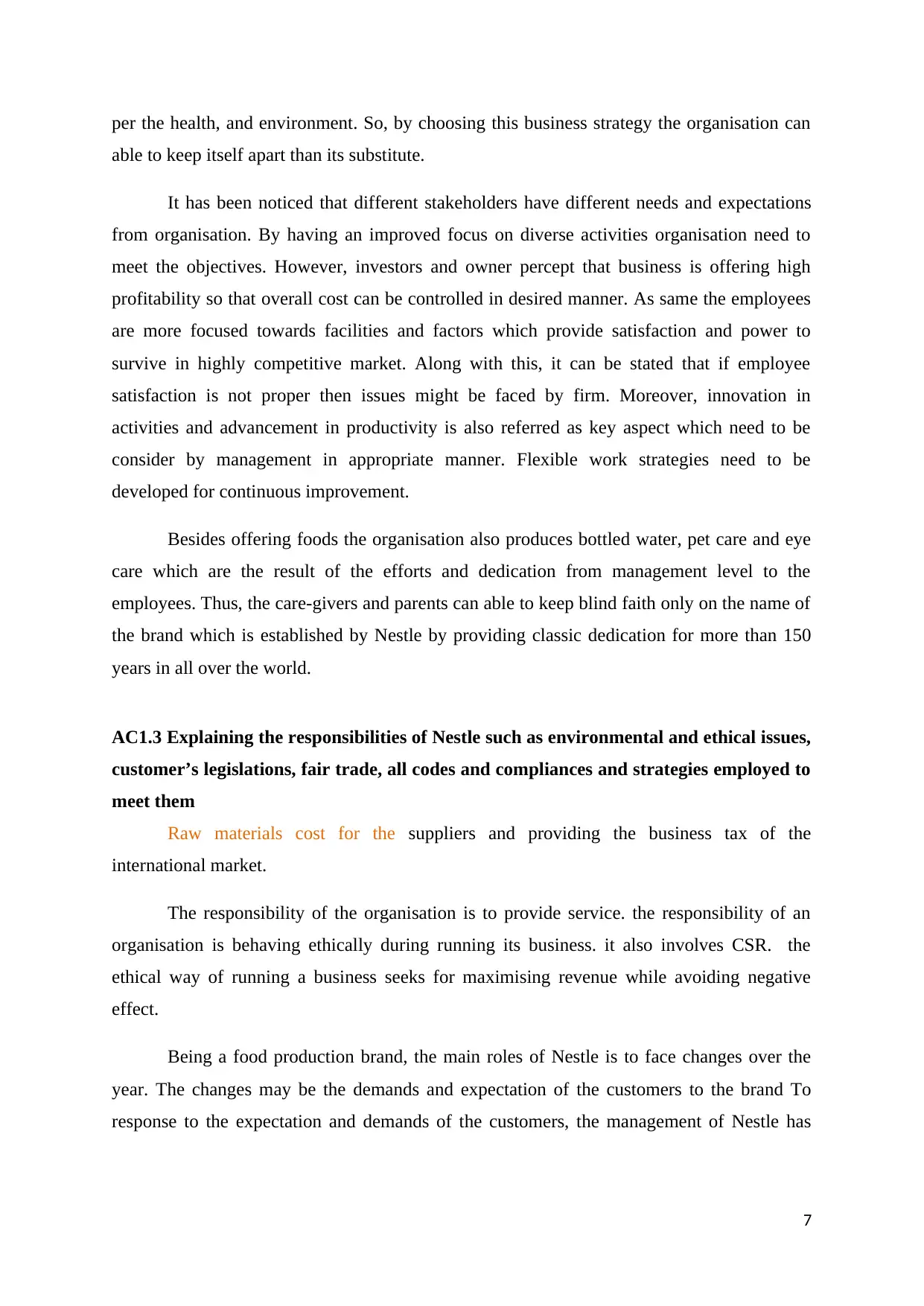
per the health, and environment. So, by choosing this business strategy the organisation can
able to keep itself apart than its substitute.
It has been noticed that different stakeholders have different needs and expectations
from organisation. By having an improved focus on diverse activities organisation need to
meet the objectives. However, investors and owner percept that business is offering high
profitability so that overall cost can be controlled in desired manner. As same the employees
are more focused towards facilities and factors which provide satisfaction and power to
survive in highly competitive market. Along with this, it can be stated that if employee
satisfaction is not proper then issues might be faced by firm. Moreover, innovation in
activities and advancement in productivity is also referred as key aspect which need to be
consider by management in appropriate manner. Flexible work strategies need to be
developed for continuous improvement.
Besides offering foods the organisation also produces bottled water, pet care and eye
care which are the result of the efforts and dedication from management level to the
employees. Thus, the care-givers and parents can able to keep blind faith only on the name of
the brand which is established by Nestle by providing classic dedication for more than 150
years in all over the world.
AC1.3 Explaining the responsibilities of Nestle such as environmental and ethical issues,
customer’s legislations, fair trade, all codes and compliances and strategies employed to
meet them
Raw materials cost for the suppliers and providing the business tax of the
international market.
The responsibility of the organisation is to provide service. the responsibility of an
organisation is behaving ethically during running its business. it also involves CSR. the
ethical way of running a business seeks for maximising revenue while avoiding negative
effect.
Being a food production brand, the main roles of Nestle is to face changes over the
year. The changes may be the demands and expectation of the customers to the brand To
response to the expectation and demands of the customers, the management of Nestle has
7
able to keep itself apart than its substitute.
It has been noticed that different stakeholders have different needs and expectations
from organisation. By having an improved focus on diverse activities organisation need to
meet the objectives. However, investors and owner percept that business is offering high
profitability so that overall cost can be controlled in desired manner. As same the employees
are more focused towards facilities and factors which provide satisfaction and power to
survive in highly competitive market. Along with this, it can be stated that if employee
satisfaction is not proper then issues might be faced by firm. Moreover, innovation in
activities and advancement in productivity is also referred as key aspect which need to be
consider by management in appropriate manner. Flexible work strategies need to be
developed for continuous improvement.
Besides offering foods the organisation also produces bottled water, pet care and eye
care which are the result of the efforts and dedication from management level to the
employees. Thus, the care-givers and parents can able to keep blind faith only on the name of
the brand which is established by Nestle by providing classic dedication for more than 150
years in all over the world.
AC1.3 Explaining the responsibilities of Nestle such as environmental and ethical issues,
customer’s legislations, fair trade, all codes and compliances and strategies employed to
meet them
Raw materials cost for the suppliers and providing the business tax of the
international market.
The responsibility of the organisation is to provide service. the responsibility of an
organisation is behaving ethically during running its business. it also involves CSR. the
ethical way of running a business seeks for maximising revenue while avoiding negative
effect.
Being a food production brand, the main roles of Nestle is to face changes over the
year. The changes may be the demands and expectation of the customers to the brand To
response to the expectation and demands of the customers, the management of Nestle has
7
Paraphrase This Document
Need a fresh take? Get an instant paraphrase of this document with our AI Paraphraser
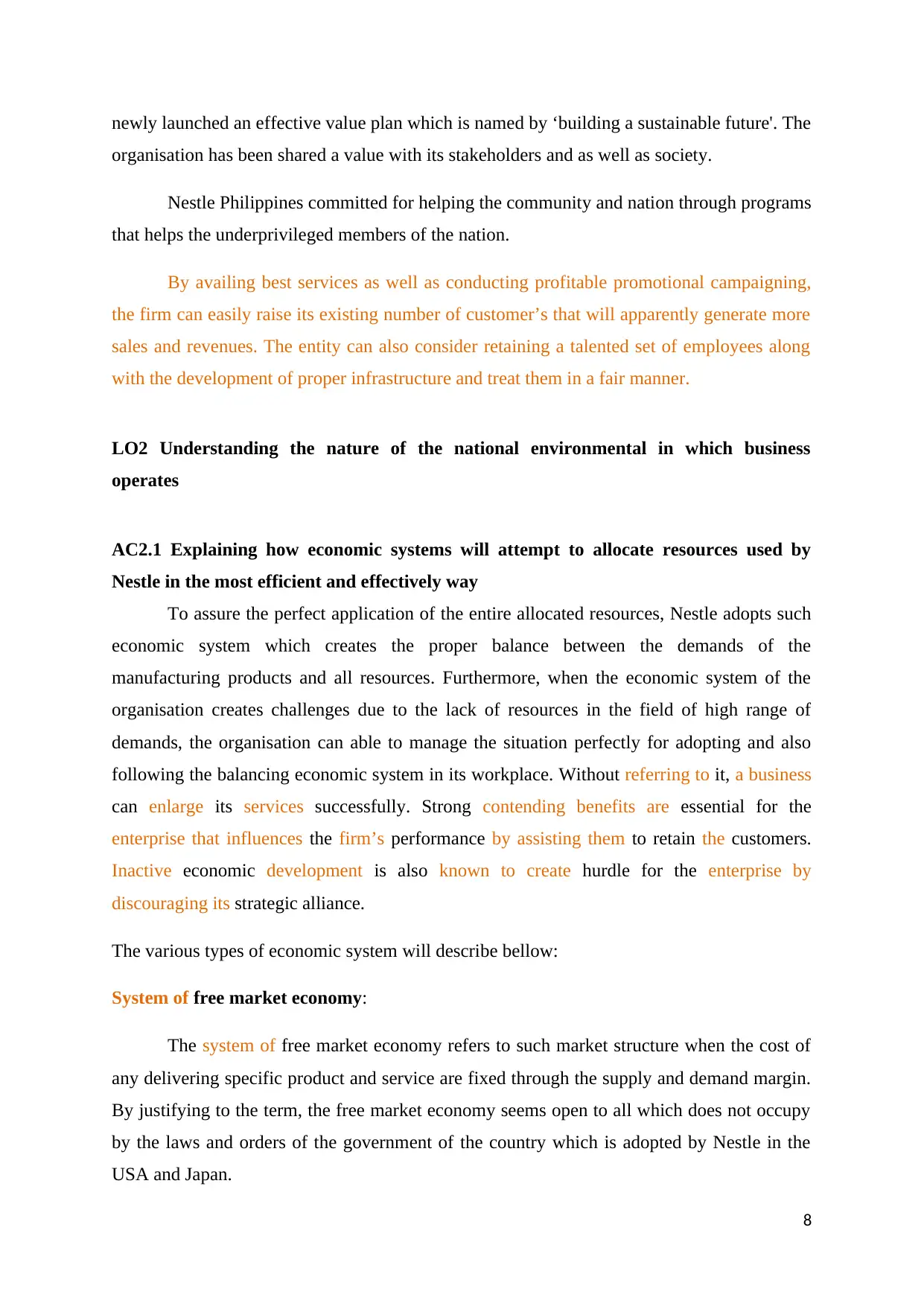
newly launched an effective value plan which is named by ‘building a sustainable future'. The
organisation has been shared a value with its stakeholders and as well as society.
Nestle Philippines committed for helping the community and nation through programs
that helps the underprivileged members of the nation.
By availing best services as well as conducting profitable promotional campaigning,
the firm can easily raise its existing number of customer’s that will apparently generate more
sales and revenues. The entity can also consider retaining a talented set of employees along
with the development of proper infrastructure and treat them in a fair manner.
LO2 Understanding the nature of the national environmental in which business
operates
AC2.1 Explaining how economic systems will attempt to allocate resources used by
Nestle in the most efficient and effectively way
To assure the perfect application of the entire allocated resources, Nestle adopts such
economic system which creates the proper balance between the demands of the
manufacturing products and all resources. Furthermore, when the economic system of the
organisation creates challenges due to the lack of resources in the field of high range of
demands, the organisation can able to manage the situation perfectly for adopting and also
following the balancing economic system in its workplace. Without referring to it, a business
can enlarge its services successfully. Strong contending benefits are essential for the
enterprise that influences the firm’s performance by assisting them to retain the customers.
Inactive economic development is also known to create hurdle for the enterprise by
discouraging its strategic alliance.
The various types of economic system will describe bellow:
System of free market economy:
The system of free market economy refers to such market structure when the cost of
any delivering specific product and service are fixed through the supply and demand margin.
By justifying to the term, the free market economy seems open to all which does not occupy
by the laws and orders of the government of the country which is adopted by Nestle in the
USA and Japan.
8
organisation has been shared a value with its stakeholders and as well as society.
Nestle Philippines committed for helping the community and nation through programs
that helps the underprivileged members of the nation.
By availing best services as well as conducting profitable promotional campaigning,
the firm can easily raise its existing number of customer’s that will apparently generate more
sales and revenues. The entity can also consider retaining a talented set of employees along
with the development of proper infrastructure and treat them in a fair manner.
LO2 Understanding the nature of the national environmental in which business
operates
AC2.1 Explaining how economic systems will attempt to allocate resources used by
Nestle in the most efficient and effectively way
To assure the perfect application of the entire allocated resources, Nestle adopts such
economic system which creates the proper balance between the demands of the
manufacturing products and all resources. Furthermore, when the economic system of the
organisation creates challenges due to the lack of resources in the field of high range of
demands, the organisation can able to manage the situation perfectly for adopting and also
following the balancing economic system in its workplace. Without referring to it, a business
can enlarge its services successfully. Strong contending benefits are essential for the
enterprise that influences the firm’s performance by assisting them to retain the customers.
Inactive economic development is also known to create hurdle for the enterprise by
discouraging its strategic alliance.
The various types of economic system will describe bellow:
System of free market economy:
The system of free market economy refers to such market structure when the cost of
any delivering specific product and service are fixed through the supply and demand margin.
By justifying to the term, the free market economy seems open to all which does not occupy
by the laws and orders of the government of the country which is adopted by Nestle in the
USA and Japan.
8
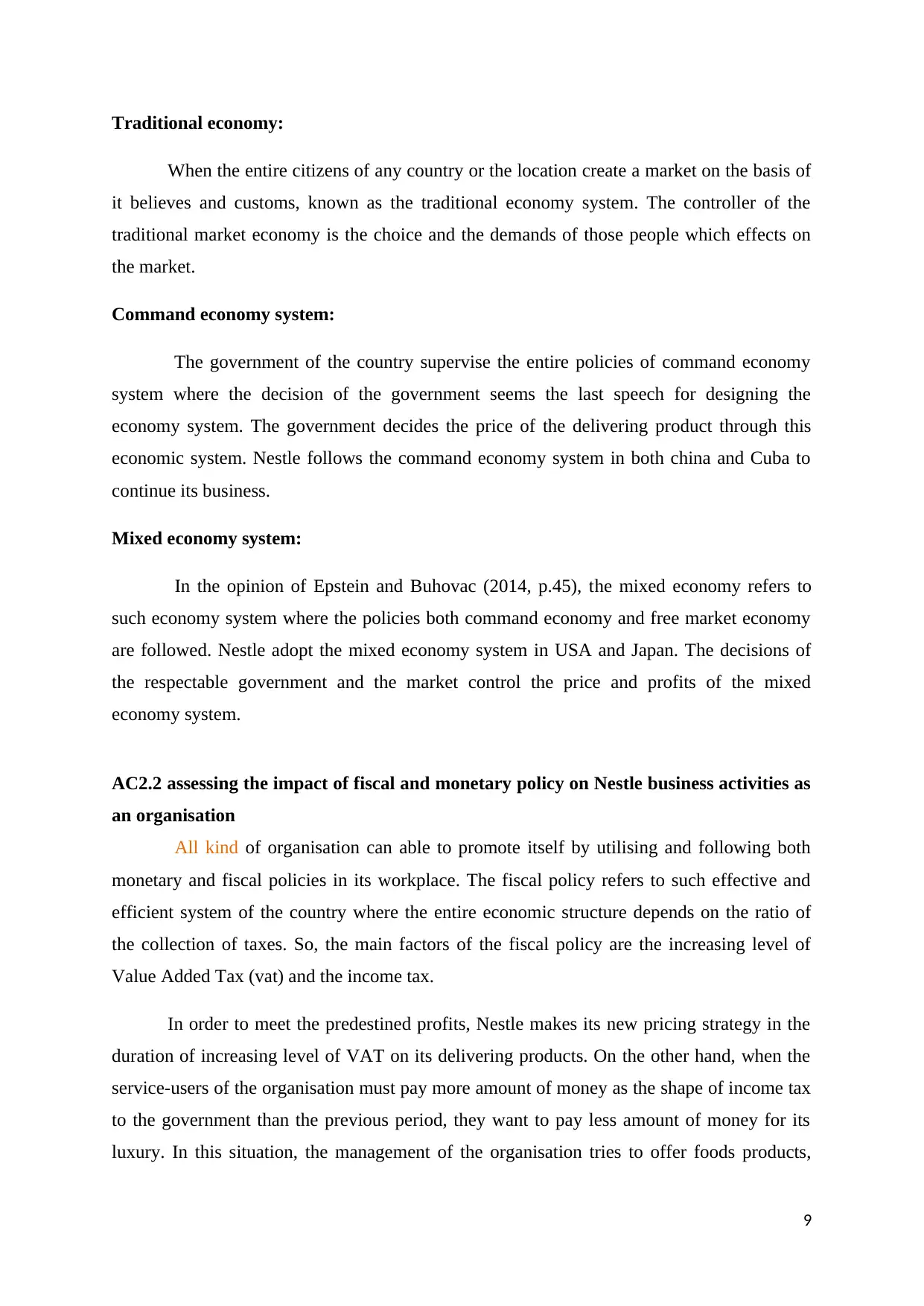
Traditional economy:
When the entire citizens of any country or the location create a market on the basis of
it believes and customs, known as the traditional economy system. The controller of the
traditional market economy is the choice and the demands of those people which effects on
the market.
Command economy system:
The government of the country supervise the entire policies of command economy
system where the decision of the government seems the last speech for designing the
economy system. The government decides the price of the delivering product through this
economic system. Nestle follows the command economy system in both china and Cuba to
continue its business.
Mixed economy system:
In the opinion of Epstein and Buhovac (2014, p.45), the mixed economy refers to
such economy system where the policies both command economy and free market economy
are followed. Nestle adopt the mixed economy system in USA and Japan. The decisions of
the respectable government and the market control the price and profits of the mixed
economy system.
AC2.2 assessing the impact of fiscal and monetary policy on Nestle business activities as
an organisation
All kind of organisation can able to promote itself by utilising and following both
monetary and fiscal policies in its workplace. The fiscal policy refers to such effective and
efficient system of the country where the entire economic structure depends on the ratio of
the collection of taxes. So, the main factors of the fiscal policy are the increasing level of
Value Added Tax (vat) and the income tax.
In order to meet the predestined profits, Nestle makes its new pricing strategy in the
duration of increasing level of VAT on its delivering products. On the other hand, when the
service-users of the organisation must pay more amount of money as the shape of income tax
to the government than the previous period, they want to pay less amount of money for its
luxury. In this situation, the management of the organisation tries to offer foods products,
9
When the entire citizens of any country or the location create a market on the basis of
it believes and customs, known as the traditional economy system. The controller of the
traditional market economy is the choice and the demands of those people which effects on
the market.
Command economy system:
The government of the country supervise the entire policies of command economy
system where the decision of the government seems the last speech for designing the
economy system. The government decides the price of the delivering product through this
economic system. Nestle follows the command economy system in both china and Cuba to
continue its business.
Mixed economy system:
In the opinion of Epstein and Buhovac (2014, p.45), the mixed economy refers to
such economy system where the policies both command economy and free market economy
are followed. Nestle adopt the mixed economy system in USA and Japan. The decisions of
the respectable government and the market control the price and profits of the mixed
economy system.
AC2.2 assessing the impact of fiscal and monetary policy on Nestle business activities as
an organisation
All kind of organisation can able to promote itself by utilising and following both
monetary and fiscal policies in its workplace. The fiscal policy refers to such effective and
efficient system of the country where the entire economic structure depends on the ratio of
the collection of taxes. So, the main factors of the fiscal policy are the increasing level of
Value Added Tax (vat) and the income tax.
In order to meet the predestined profits, Nestle makes its new pricing strategy in the
duration of increasing level of VAT on its delivering products. On the other hand, when the
service-users of the organisation must pay more amount of money as the shape of income tax
to the government than the previous period, they want to pay less amount of money for its
luxury. In this situation, the management of the organisation tries to offer foods products,
9
⊘ This is a preview!⊘
Do you want full access?
Subscribe today to unlock all pages.

Trusted by 1+ million students worldwide
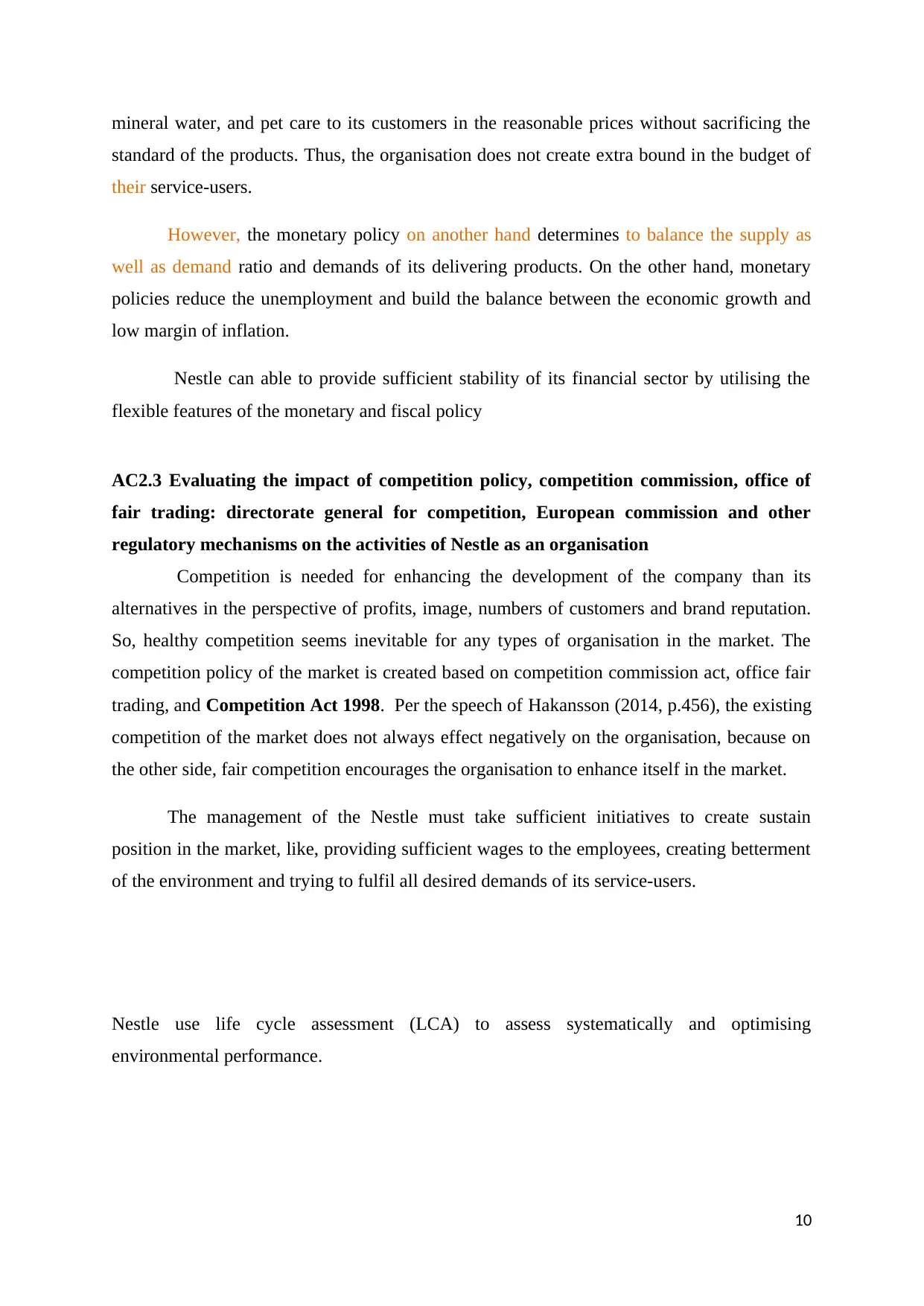
mineral water, and pet care to its customers in the reasonable prices without sacrificing the
standard of the products. Thus, the organisation does not create extra bound in the budget of
their service-users.
However, the monetary policy on another hand determines to balance the supply as
well as demand ratio and demands of its delivering products. On the other hand, monetary
policies reduce the unemployment and build the balance between the economic growth and
low margin of inflation.
Nestle can able to provide sufficient stability of its financial sector by utilising the
flexible features of the monetary and fiscal policy
AC2.3 Evaluating the impact of competition policy, competition commission, office of
fair trading: directorate general for competition, European commission and other
regulatory mechanisms on the activities of Nestle as an organisation
Competition is needed for enhancing the development of the company than its
alternatives in the perspective of profits, image, numbers of customers and brand reputation.
So, healthy competition seems inevitable for any types of organisation in the market. The
competition policy of the market is created based on competition commission act, office fair
trading, and Competition Act 1998. Per the speech of Hakansson (2014, p.456), the existing
competition of the market does not always effect negatively on the organisation, because on
the other side, fair competition encourages the organisation to enhance itself in the market.
The management of the Nestle must take sufficient initiatives to create sustain
position in the market, like, providing sufficient wages to the employees, creating betterment
of the environment and trying to fulfil all desired demands of its service-users.
Nestle use life cycle assessment (LCA) to assess systematically and optimising
environmental performance.
10
standard of the products. Thus, the organisation does not create extra bound in the budget of
their service-users.
However, the monetary policy on another hand determines to balance the supply as
well as demand ratio and demands of its delivering products. On the other hand, monetary
policies reduce the unemployment and build the balance between the economic growth and
low margin of inflation.
Nestle can able to provide sufficient stability of its financial sector by utilising the
flexible features of the monetary and fiscal policy
AC2.3 Evaluating the impact of competition policy, competition commission, office of
fair trading: directorate general for competition, European commission and other
regulatory mechanisms on the activities of Nestle as an organisation
Competition is needed for enhancing the development of the company than its
alternatives in the perspective of profits, image, numbers of customers and brand reputation.
So, healthy competition seems inevitable for any types of organisation in the market. The
competition policy of the market is created based on competition commission act, office fair
trading, and Competition Act 1998. Per the speech of Hakansson (2014, p.456), the existing
competition of the market does not always effect negatively on the organisation, because on
the other side, fair competition encourages the organisation to enhance itself in the market.
The management of the Nestle must take sufficient initiatives to create sustain
position in the market, like, providing sufficient wages to the employees, creating betterment
of the environment and trying to fulfil all desired demands of its service-users.
Nestle use life cycle assessment (LCA) to assess systematically and optimising
environmental performance.
10
Paraphrase This Document
Need a fresh take? Get an instant paraphrase of this document with our AI Paraphraser
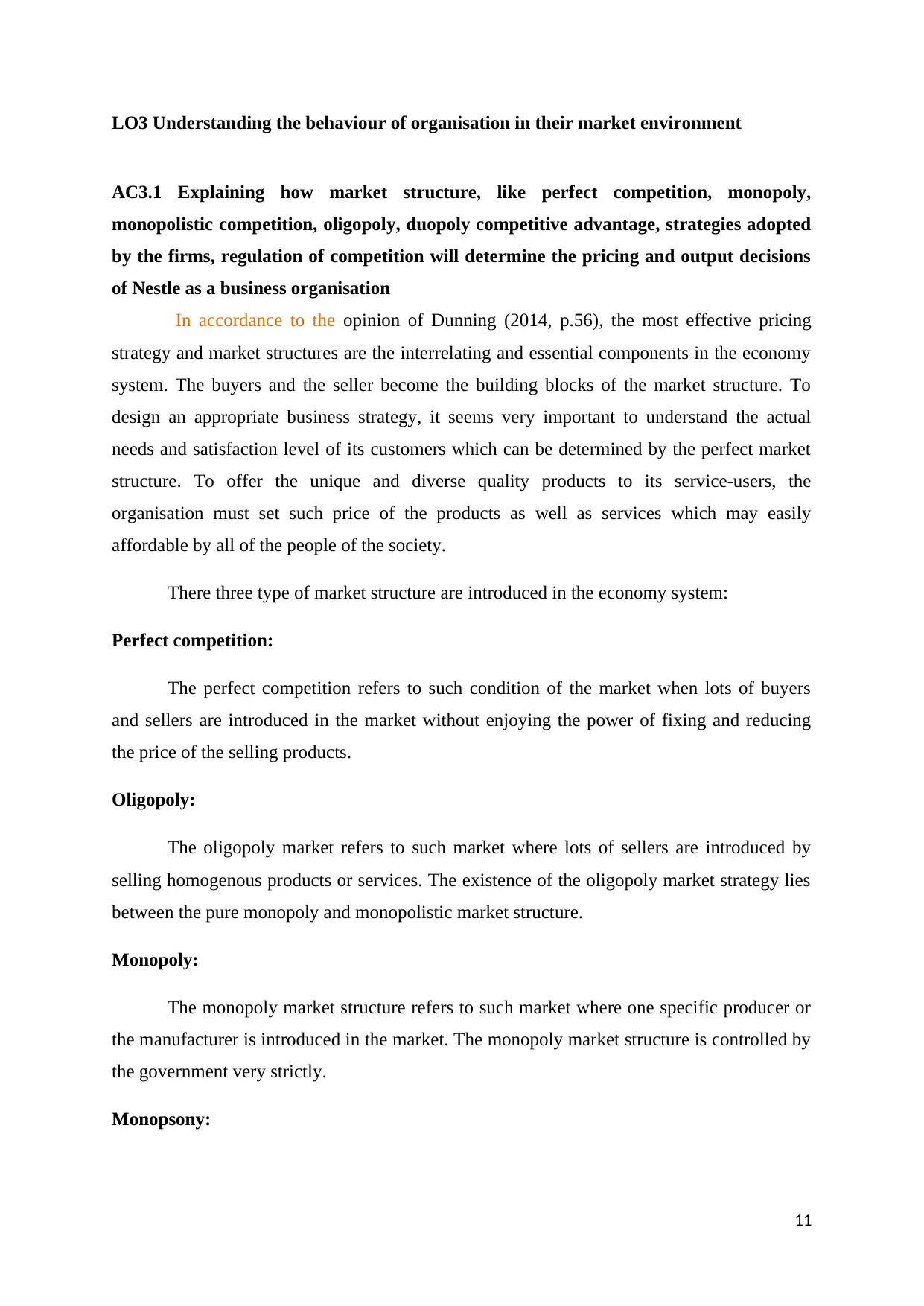
LO3 Understanding the behaviour of organisation in their market environment
AC3.1 Explaining how market structure, like perfect competition, monopoly,
monopolistic competition, oligopoly, duopoly competitive advantage, strategies adopted
by the firms, regulation of competition will determine the pricing and output decisions
of Nestle as a business organisation
In accordance to the opinion of Dunning (2014, p.56), the most effective pricing
strategy and market structures are the interrelating and essential components in the economy
system. The buyers and the seller become the building blocks of the market structure. To
design an appropriate business strategy, it seems very important to understand the actual
needs and satisfaction level of its customers which can be determined by the perfect market
structure. To offer the unique and diverse quality products to its service-users, the
organisation must set such price of the products as well as services which may easily
affordable by all of the people of the society.
There three type of market structure are introduced in the economy system:
Perfect competition:
The perfect competition refers to such condition of the market when lots of buyers
and sellers are introduced in the market without enjoying the power of fixing and reducing
the price of the selling products.
Oligopoly:
The oligopoly market refers to such market where lots of sellers are introduced by
selling homogenous products or services. The existence of the oligopoly market strategy lies
between the pure monopoly and monopolistic market structure.
Monopoly:
The monopoly market structure refers to such market where one specific producer or
the manufacturer is introduced in the market. The monopoly market structure is controlled by
the government very strictly.
Monopsony:
11
AC3.1 Explaining how market structure, like perfect competition, monopoly,
monopolistic competition, oligopoly, duopoly competitive advantage, strategies adopted
by the firms, regulation of competition will determine the pricing and output decisions
of Nestle as a business organisation
In accordance to the opinion of Dunning (2014, p.56), the most effective pricing
strategy and market structures are the interrelating and essential components in the economy
system. The buyers and the seller become the building blocks of the market structure. To
design an appropriate business strategy, it seems very important to understand the actual
needs and satisfaction level of its customers which can be determined by the perfect market
structure. To offer the unique and diverse quality products to its service-users, the
organisation must set such price of the products as well as services which may easily
affordable by all of the people of the society.
There three type of market structure are introduced in the economy system:
Perfect competition:
The perfect competition refers to such condition of the market when lots of buyers
and sellers are introduced in the market without enjoying the power of fixing and reducing
the price of the selling products.
Oligopoly:
The oligopoly market refers to such market where lots of sellers are introduced by
selling homogenous products or services. The existence of the oligopoly market strategy lies
between the pure monopoly and monopolistic market structure.
Monopoly:
The monopoly market structure refers to such market where one specific producer or
the manufacturer is introduced in the market. The monopoly market structure is controlled by
the government very strictly.
Monopsony:
11
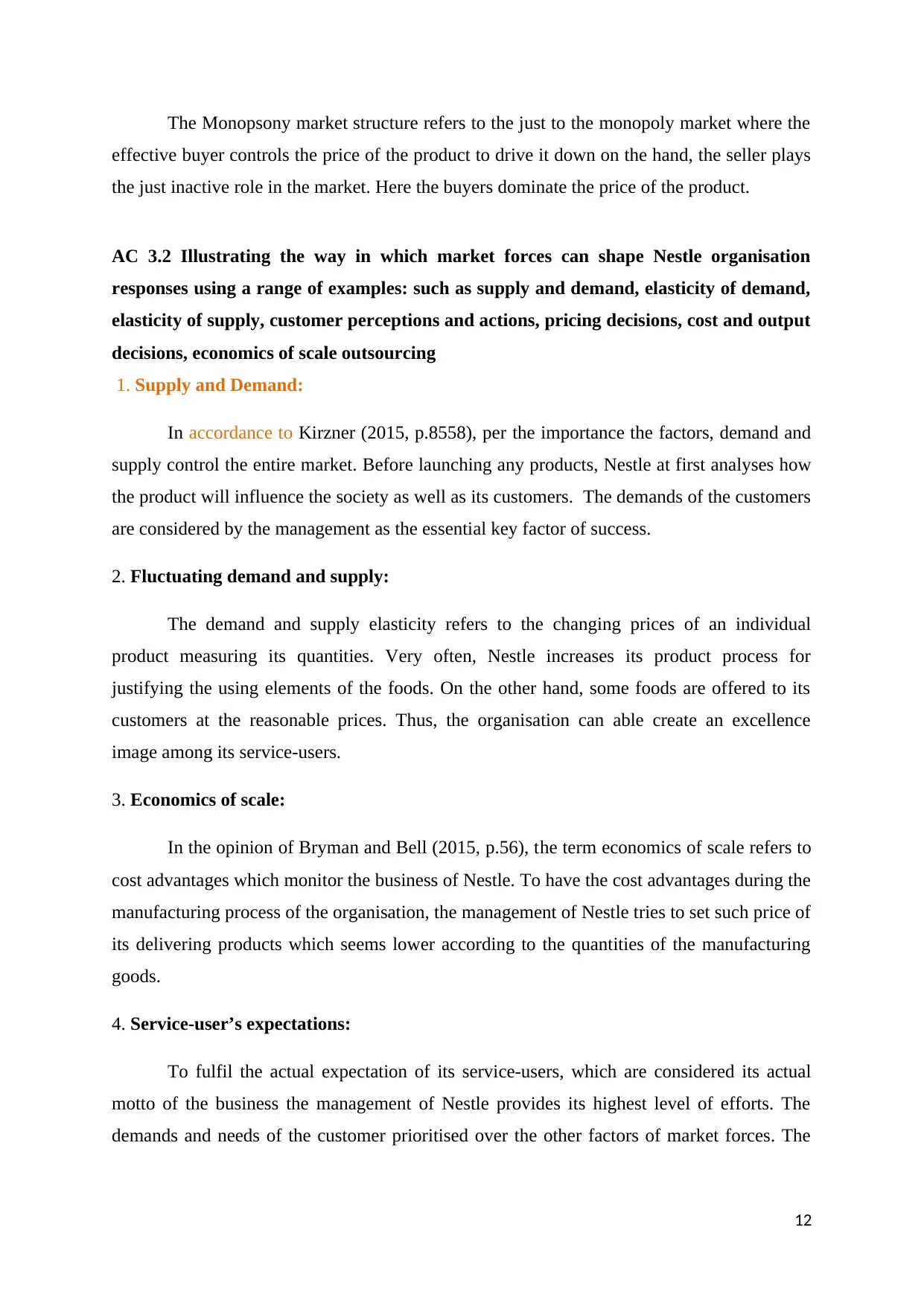
The Monopsony market structure refers to the just to the monopoly market where the
effective buyer controls the price of the product to drive it down on the hand, the seller plays
the just inactive role in the market. Here the buyers dominate the price of the product.
AC 3.2 Illustrating the way in which market forces can shape Nestle organisation
responses using a range of examples: such as supply and demand, elasticity of demand,
elasticity of supply, customer perceptions and actions, pricing decisions, cost and output
decisions, economics of scale outsourcing
1. Supply and Demand:
In accordance to Kirzner (2015, p.8558), per the importance the factors, demand and
supply control the entire market. Before launching any products, Nestle at first analyses how
the product will influence the society as well as its customers. The demands of the customers
are considered by the management as the essential key factor of success.
2. Fluctuating demand and supply:
The demand and supply elasticity refers to the changing prices of an individual
product measuring its quantities. Very often, Nestle increases its product process for
justifying the using elements of the foods. On the other hand, some foods are offered to its
customers at the reasonable prices. Thus, the organisation can able create an excellence
image among its service-users.
3. Economics of scale:
In the opinion of Bryman and Bell (2015, p.56), the term economics of scale refers to
cost advantages which monitor the business of Nestle. To have the cost advantages during the
manufacturing process of the organisation, the management of Nestle tries to set such price of
its delivering products which seems lower according to the quantities of the manufacturing
goods.
4. Service-user’s expectations:
To fulfil the actual expectation of its service-users, which are considered its actual
motto of the business the management of Nestle provides its highest level of efforts. The
demands and needs of the customer prioritised over the other factors of market forces. The
12
effective buyer controls the price of the product to drive it down on the hand, the seller plays
the just inactive role in the market. Here the buyers dominate the price of the product.
AC 3.2 Illustrating the way in which market forces can shape Nestle organisation
responses using a range of examples: such as supply and demand, elasticity of demand,
elasticity of supply, customer perceptions and actions, pricing decisions, cost and output
decisions, economics of scale outsourcing
1. Supply and Demand:
In accordance to Kirzner (2015, p.8558), per the importance the factors, demand and
supply control the entire market. Before launching any products, Nestle at first analyses how
the product will influence the society as well as its customers. The demands of the customers
are considered by the management as the essential key factor of success.
2. Fluctuating demand and supply:
The demand and supply elasticity refers to the changing prices of an individual
product measuring its quantities. Very often, Nestle increases its product process for
justifying the using elements of the foods. On the other hand, some foods are offered to its
customers at the reasonable prices. Thus, the organisation can able create an excellence
image among its service-users.
3. Economics of scale:
In the opinion of Bryman and Bell (2015, p.56), the term economics of scale refers to
cost advantages which monitor the business of Nestle. To have the cost advantages during the
manufacturing process of the organisation, the management of Nestle tries to set such price of
its delivering products which seems lower according to the quantities of the manufacturing
goods.
4. Service-user’s expectations:
To fulfil the actual expectation of its service-users, which are considered its actual
motto of the business the management of Nestle provides its highest level of efforts. The
demands and needs of the customer prioritised over the other factors of market forces. The
12
⊘ This is a preview!⊘
Do you want full access?
Subscribe today to unlock all pages.

Trusted by 1+ million students worldwide
1 out of 18
Related Documents
Your All-in-One AI-Powered Toolkit for Academic Success.
+13062052269
info@desklib.com
Available 24*7 on WhatsApp / Email
![[object Object]](/_next/static/media/star-bottom.7253800d.svg)
Unlock your academic potential
Copyright © 2020–2025 A2Z Services. All Rights Reserved. Developed and managed by ZUCOL.





